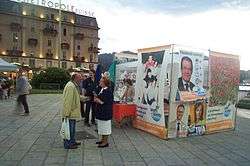The Olive Tree (Italy)
The Olive Tree (Italian: L'Ulivo) was a denomination used for several successive centre-left political and electoral alliances of Italian political parties from 1995 to 2007.
The Olive Tree L'Ulivo | |
|---|---|
 | |
| Leader | Romano Prodi (1995–1998, 2004–2007) Massimo D'Alema (1998–2000) Francesco Rutelli (2000–2004) |
| Founded | 6 March 1995 |
| Dissolved | 14 October 2007 |
| Merged into | Democratic Party |
| Headquarters | via S. Andrea delle Fratte, 16 00186 Rome |
| Newspaper | none |
| Political position | Centre-left[1][2][3][4] |
| National affiliation | Ulivo–PRC (1996–98) The Union (2005–07) |
| Website | |
| www | |
The historical leader and ideologue of these coalitions was Romano Prodi, Professor of Economics and former leftist Christian Democrat, who invented the name and the symbol of The Olive Tree with Arturo Parisi in 1995. For the 2006 general election The Olive Tree was largely supplanted by a wider Prodi-led alliance called The Union, while The Olive Tree remained a smaller federation of parties which merged to form the Democratic Party in October 2007, which continues to be the lead party of an unnamed centre-left coalition.
History
The Olive Tree coalition
In government with Prodi (1996–1998)
On 21 April 1996, The Olive Tree won 1996 general election in alliance with the Communist Refoundation Party (PRC), making Romano Prodi the Prime Minister of Italy. It was the first time since 1946 that the Communists, now gathered in the Democratic Party of the Left, took part in the government of the country and one of their leaders, Walter Veltroni, who ran in ticket with Prodi in a long electoral campaign, was Deputy Prime Minister.
In 1996 the coalition was formed by the following parties:
| Party | Ideology | Leader | |
|---|---|---|---|
| Democratic Party of the Left (PDS) | Democratic socialism | Massimo D'Alema | |
| Italian People's Party (PPI) | Christian democracy | Franco Marini | |
| Italian Renewal (RI) | Liberalism | Lamberto Dini | |
| Federation of the Greens (FdV) | Green politics | Carlo Ripa di Meana | |
| Italian Socialists (SI) | Social democracy | Enrico Boselli | |
| Democratic Union (UD) | Social liberalism | Antonio Maccanico | |
| Segni Pact (Patto) | Centrism | Mariotto Segni | |
| The Network (Rete) | Anti-Mafia politics | Leoluca Orlando | |
| South Tyrolean People's Party (SVP) | Regionalism | Luis Durnwalder | |
| Italian Republican Party (PRI) | Social liberalism | Giorgio La Malfa | |
Besides the external support of PRC, the coalition received the support also of some minor parties: the Italian Republican Party (PRI, social-liberal), The Network (social-liberal), the South Tyrolean People's Party (regionalist) and some other minor parties which later merged with PDS.
From D'Alema to Rutelli (1998–2004)
On 9 October 1998, the Prodi I Cabinet fell when PRC left the alliance. Since 21 October 1998 The Olive Tree was the core of the governments led by Massimo D'Alema (I and II Cabinet, 1998–2000) and by Giuliano Amato (II Cabinet, 2000–2001). When D'Alema became Prime Minister, it was the first time ever in Italy and in Europe that an heir of the communist tradition came to lead a government.
On 13 May 2001, led by Francesco Rutelli, who ran in ticket with Piero Fassino, the coalition lost the general elections against Silvio Berlusconi and his House of Freedoms centre-right coalition. In the 2001 general election, the coalition was composed of six parties:
The Olive Tree list and federation
On 12 June 2004, The Olive Tree, as United in the Olive Tree (Uniti nell'Ulivo), ran in the European Parliament election gaining 31.1% of popular votes. The Olive Tree of 2004 was a tighter alliance of only four parties:
| Party | Ideology | Leader | |
|---|---|---|---|
| Democrats of the Left (DS) | Social democracy | Piero Fassino | |
| Democracy is Freedom – The Daisy (DL) | Centrism | Francesco Rutelli | |
| Italian Democratic Socialists (SDI) | Social democracy | Enrico Boselli | |
| European Republican Movement (MRE) | Social liberalism | Luciana Sbarbati | |
On 13 September 2004, The Olive Tree was transformed in the Federation of The Olive Tree, consisting of same four parties that campaigned together in the European elections that summer. Romano Prodi, who came back to politics in that year, after five years of President of the European Commission, was elected President of the federation, which was to become the core of a larger centre-left coalition.

On 10 February 2005, the name and logo of that larger electoral coalition was presented. Its name was The Union (L'Unione). It comprised the Federation of The Olive Tree, the Communist Refoundation Party (PRC), the Party of Italian Communists (PdCI), Italy of Values (IdV), the Federation of the Greens and other minor parties.
The Democratic Party
The Democrats of the Left (DS), Democracy is Freedom – The Daisy (DL) and the European Republicans Movement (MRE) decided to form a joint electoral list for the 2006 general election. Also the Italian Democratic Socialist Party (a different party from SDI) and The Italian Socialists had candidates in the list. The Italian Democratic Socialists (SDI), which were part of the federation and fight the 2004 European and the 2005 regional elections within it, decided not to take part of the joint electoral list for the 2006 general election and, otherwise, to form a common list with the Italian Radicals called Rose in the Fist within The Union coalition.
DS and DL were heavily involved in the foundation of a new unitary centre-left party, the Democratic Party, a project strongly supported by Romano Prodi since his entrance into politics in 1995. This party was founded on 14 October 2007 and Walter Veltroni was elected party leader by voters in an open primary.
Electoral results
Italian Parliament
| Chamber of Deputies | |||||
| Election year | Votes | % | Seats | +/− | Leader |
|---|---|---|---|---|---|
| 1996 | 15,758,981 (1st) | 42.2 | 285 / 630 |
||
| 2001 | 16,209,944 (2nd) | 43.5 | 247 / 630 |
||
| 2006 | 11,928,362 (1st) | 31.2 | 220 / 630 |
||
| Senate of the Republic | |||||
| Election year | Votes | % | Seats | +/− | Leader |
|---|---|---|---|---|---|
| 1996 | 13,444,977 (1st) | 41.2 | 157 / 315 |
||
| 2001 | 13,282,495 (2nd) | 39.2 | 128 / 315 |
||
| 2006 | 9,664,935 (1st) | 28.6 | 101 / 315 |
||
European Parliament
| European Parliament | |||||
| Election year | Votes | % | Seats | +/− | Leader |
|---|---|---|---|---|---|
| 2004 | 10,105,836 (1st) | 31.2 | 24 / 78 |
||
Symbols
 1996 & 2006
1996 & 2006.jpg) 2001
2001.jpg) 2004
2004.jpg) 2005
2005
Further reading
- Salvati, Michele (2004). The Olivo: Death or Transfiguration?. Italy Between Europeanization and Domestic Politics. Italian Politics. 19. Berghahn. pp. 45–62.
See also
References
- Donald F. Busky (2002). Communism in History and Theory: The European Experience. Greenwood Publishing Group. p. 57. ISBN 978-0-275-97734-4. Retrieved 24 July 2013.
- Mario B. Mignone (2008). Italy Today: Facing the Challenges of the New Millennium. Peter Lang. p. 58. ISBN 978-1-4331-0187-8. Retrieved 24 July 2013.
- James L. Newell (2010). The Politics of Italy: Governance in a Normal Country. Cambridge University Press. p. 39. ISBN 978-0-521-84070-5. Retrieved 24 July 2013.
- Daniela Giannetti; Rosa Mulé (2007). "The Democratici di Sinistra: In Search of a New Identity". In Anna Bosco; Leonardo Morlino (eds.). Party Change in Southern Europe. Routledge. p. 135. ISBN 978-1-136-76777-7.